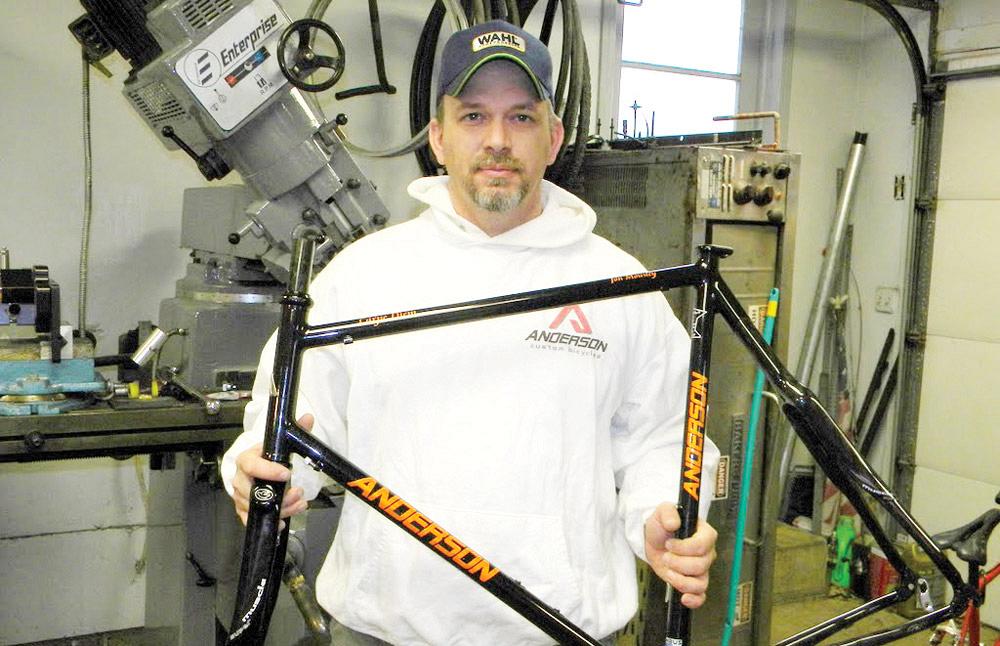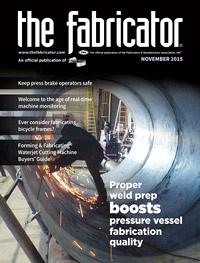Contributing Writer
- FMA
- The Fabricator
- FABTECH
- Canadian Metalworking
Categories
- Additive Manufacturing
- Aluminum Welding
- Arc Welding
- Assembly and Joining
- Automation and Robotics
- Bending and Forming
- Consumables
- Cutting and Weld Prep
- Electric Vehicles
- En Español
- Finishing
- Hydroforming
- Laser Cutting
- Laser Welding
- Machining
- Manufacturing Software
- Materials Handling
- Metals/Materials
- Oxyfuel Cutting
- Plasma Cutting
- Power Tools
- Punching and Other Holemaking
- Roll Forming
- Safety
- Sawing
- Shearing
- Shop Management
- Testing and Measuring
- Tube and Pipe Fabrication
- Tube and Pipe Production
- Waterjet Cutting
Industry Directory
Webcasts
Podcasts
FAB 40
Advertise
Subscribe
Account Login
Search
Building a better bike
Shops can expand their business by jumping into bicycle fabrication
- By Jeffrey Dean
- November 2, 2015
- Article
- Shop Management
It is the Manifest Destiny of a business to expand. But what happens if the market for your service is saturated or the economy is soft?
That’s when you start searching the nooks and crannies of your market for places you may have overlooked. What you’re looking for is a new niche.
Here’s one you may have overlooked. Last year Americans bought around 18 million bicycles. That tallies to $6.1 billion, up from 2013’s $5.8 billion, according to the National Bicycle Dealers Association (NBDA).
What drives this burgeoning market? First, the bike market is branching out into various specialty areas, each requiring a different type of bike. The result is a market teeming with more bikes than you can shake a spoke at. There are road bikes, touring bikes, utility bikes, cargo bikes, campus bikes, cruisers, mountain bikes, hybrid mountain bikes, hard-tail mountain bikes, tandem bikes, cross-country bikes, and even bikes you can pedal over water, called water bikes or hydrobikes. Suffice to say, there is elbow room in the market.
Second, the country is becoming more bike-friendly. The federal government has budgeted significant transportation money for construction of bike paths and road improvements to accommodate bike traffic. Local municipalities seek out these funds as they look to entice anyone they can to abandon the already clogged roadways in favor of a motorless means of transportation.
So where do you fit in? NBDA reports that specialty bike sellers, while only 14 percent of the total unit bicycle sales, account for 50 percent of the dollar volume. What are specialty bike sellers? That’s the high-end group that includes, to a great extent, custom bike-makers.
That segment looks like it is going to continue to grow. According to IBISWorld, an industry market research firm, “Over the next five years, the industry is expected to double down on creating high-quality products that consumers are willing to pay a premium for.”
By high-quality products, they mean custom bikes. And where do these custom bikes come from? They’re fabricated. In shops just like yours.
The fact is, a custom bike shop is merely a full fabrication shop that produces something you can ride on. The people who operate these shops have the same basic skills that you have plied over the years. Bike-making involves welding and brazing, cutting, bending, and milling—the core skills of the metal trades.
While the skills needed to make bikes are similar, every bike-maker’s tale of how they got started in the business is different.

Figure 1
Dave Anderson of Anderson Custom Bicycles, St. Paul,
Minn., is a one-man show. He works on all aspects of the
custom bicycle fames he builds for clients.
Anderson’s Tale
Dave Anderson always loved bikes (see Figure 1). He also loved hanging out with his grandfather on the family farm. It was there that he first learned the fabrication skills that would enable him to pursue his dream of being a custom bike-maker.
Anderson’s grandfather taught him to weld when he was 8. By the time he was in high school, he was entering and winning fabrication contests. He was second in the nation in the 1984 National Agricultural Mechanics competition. And that was the year, Anderson recalled, that the contest involved an inordinate amount of brazing and welding, which gave him a decided advantage.
Anderson’s creations come from his St. Paul, Minn., shop where his shop cuts, bends, brazes, grinds, and polishes a specialty stainless steel (Allegheny Ludlum’s AL 17-4™ Precipitation Hardening Alloy, Type 630), which is a chromium-copper precipitation-hardening steel.
Anderson cuts with a basic chop saw fitted with an abrasive wheel. The brazing is also pretty basic: an oxyacetylene-fueled torch with a No. 2 nozzle tip. His benders are basic fare as well. One is an in-house creation, sans hydraulics; the other is a 12-inch-radius machine, which is also manual.
Stainless is a stubborn material, so he often heats the pieces with a torch before bending. A bright red color tells him when to start cranking the lever.
While most of his bikes have polished stainless finishes, an occasional customer craves a paint job. He does the pretreatment and painting in-house. The pretreatment usually consists of a bead blast or emery cloth to give the material enough tooth to hold the urethane paint.
Wojcik’s World
Ted Wojcik’s shop is as much an exemplar of a fab shop as is Dave Anderson’s. They differ mainly in the type of joinery. While Anderson favors lugs and brazing, Wojcik uses gas tungsten arc welding (GTAW) to join nearly everything.
Interestingly, GTAW didn’t always enjoy widespread acceptance in the bike-maker universe. Bike tubes are typically butted; the ends have thicker walls. This produces a temperature gradient that isn’t conducive to any kind of peace of mind with an arc weld. The problem was solved with the advent of short-butted sections of steel tube from the bike frame guru Tom Ritchey. With the shorter butts, the tubes have a shorter temperature gradient, designed for GTAW.
Wojcik (see Figure 2) works mainly with aircraft-grade chromoly steel, a high-carbon chromium and molybdenum alloy. Marketed as an air-hardening supersteel, the material gets harder and stronger after welding.
If the customer has a yen for aluminum, Wojcik will work with 6000 or 7000 series alloys, but he’s wary of the material. He feels aluminum has a more unpredictable fatigue strength than steel and requires postweld-heat treatment.

Figure 2
Ted Wojcik of Plaistow, N.H., relies on his gas tungsten
arc welding skill to produce bicycle fames.
But bending may be what really sets Wojcik apart from other bike fabricators.
“Bending is a black art,” said Wojcik, who has fashioned an interesting bender for his shop. It pulls a ball through the steel tube as it’s being bent. This minimizes the wrinkling and equalizes the stretch and compression at the bends.
The result is a smoother and more predictable bend that is less likely to have an adverse effect on a weld.
Made in Michigan
Walk into Scott Quiring’s Michigan shop and you could be walking into just about any fabrication shop in the country. Your eye pans across the tooling. There’s a GTAW power source, the ubiquitous green and yellow tanks, a press brake, a bender or two, various drill presses, band saws, a lathe, and a multiaxis CNC milling machine. He could be turning out stairs, railings, or just about anything.
For instance, his paint oven is home-built, and so are the dies for his hydraulic Di-Acro bender. The only clue that he’s turning out anything other than standard fabrication fare is the array of bikes in varying states of assembly.
Quiring (see Figure 3) came by his skills in a typical way, attending vocational classes. The only unusual part of it is his Bachelor of Science degree in business administration from Grand Valley State University.
But his first love was always bikes. He even had a fling with mountain bike racing, competing on the international circuit in the 1980s.
“One thing led to another, and I eventually got some exposure, in the ’90s, to how bikes were made,” Quiring recalled. “I learned about design with the early Windows CAD programs.”
He’d been bitten by the bike bug and had it bad. He kept taking classes, such as bike design, welding, and anything that would advance his call of making a bike.
By 1999 he was open for business and building bikes.
His bikes today are mostly creations from a grade 9 titanium alloy, often used in aerospace applications. The titanium tubes are seamless with straight sides, while the occasional steel bikes use the standard butted tubes.
Like Wojcik, he’s a devotee of GTAW. Only the braze-ons—the attachment points for accessories such as water bottles, pump pegs, and cable bosses—are actually brazed with filler.
Quiring prefers manual milling for one-offs, because there’s less setup. For larger quantities or complex designs, he said the CNC makes more sense.
Frank the Welder
Perhaps no one better exemplifies the general fabricator turned bike-maker than Frank Wadelton. Known throughout the bike-making industry as Frank the Welder, Wadelton runs a fully equipped general fabrication shop in Bellows Falls, Vt.
His machine lineup includes two Thermo-Dynamics GTAW power sources; two rigid-conduit, home-built mandrel benders; and a curious contraption of Wadelton’s own design: a bender powered by a pneumatic lug wrench he rescued from a local salvage yard (see Figure 4).
He also runs a Word War II-era 14-in. band saw. One indication of its age is the speed setting for asbestos.
A few steps away from the band saw brings you back into the 21st century with a 2½ -axis ProtoTRAK milling machine, steered by a CNC with MX2 software. It has a simple G-code converter and interface. Wadelton uses AutoCAD® to draw.
The rest of the lineup includes chop saws, horizontal band saws, belt sanders, and three more milling machines, fully manual Bridgeports.
Wadelton mostly uses GTAW for his frames, which he makes from scratch, using mostly 7005 aluminum. On customer demand, he’ll also turn out the occasional steel or titanium frame.
Wadelton started early on the path to fabricator.
“My dad was a machinist at a movie studio. I literally had metal chips in my diapers,” said Wadelton, whose first fabrication job was welding cryogenic pressure vessels. But his first love has always been bicycles, which he’s been able to nicely work into his shop output.

Figure 4
A tube bender powered by a pneumatic lug wrench is something that you don’t see in every shop. “I needed a power source [for a bender]. The lug wrench puts out 30 PSI. It’s brutally strong,” said welder Frank Wadelton.
Sadoff’s One-offs
“I learned by doing. I’ve always been a tinkerer. In 1978 I wanted to build a bike frame so I traded some bike-making materials for brazing lessons from a local bike-maker,” said Paul Sadoff, a bike-maker whose Rock Lobster Cycles shop is in Santa Cruz, Calif.
Not long after that experience, Sadoff augmented his skill with GTAW lessons in an adult education program. He talked with other builders who were willing to share their methods and skills, and when the Internet hit, he was gleaning all the bike-building lore he could.
“You can learn anything from the Internet,” Sadoff said, “but you have to be discriminating. There’s always one correct way and 10 incorrect ways [on the web].”
Not that there’s anything wrong with that. Sadoff readily conceded that mistakes are an excellent way of learning.
“There is an infinite number of mistakes you can make with a bike [fabrication]. It’s very complicated for something that seems so outwardly simple as a bicycle,” he said.
Getting Started
Obviously, a bike-maker must know the specific steps involved in making the product. But before that, the fabricator must possess the requisite metal fabrication skills. Someone who has been making railings or steps for a living is already far ahead on the learning curve than someone who, without fabrication skills, has decided to pursue a labor of love. The fabricator needs only the recipe, and that’s available from a passel of sources online.
One place to get those recipes is bikeschool.com. Another is a classic book called The Proteus Framebuilding Book: A Guide for the Novice Bicycle Framebuilder (the corresponding website is www.proteusbicycles.com). The author is listed as Dr. Paul Proteus, who actually exists only in the pages of Kurt Vonnegut’s anti-automation novel, Player Piano. The real authors of the book are Barry Konig, Steve Schuman, and several others from Proteus Bicycles, the renowned College Park, Md., shop.
That’s not to say that a couple of hours of surfing the Internet will launch your full-time bike-making business. Most edge into it, with a good deal of overlap with whatever they’ve been doing to put groceries on the table. Sadoff was a professional musician when he built his first bike in 1978 and performing gigs well after he opened a full-time bike-making business in 1984. It wasn’t until 1994 that he was able to wean himself from his job with the band.
Wadelton’s shop is still a general fabrication shop with bikes worked into the client mix. He reckons his shop to be about 50 percent bike-making. The balance is general fabrication with a heavy emphasis on automotive equipment.
“I make performance parts for cars, such as suspension systems, roll cages,” Wadelton said, “but I’ll make just about anything. I also make stainless steel equipment for the food industry.”
When all is said and done, the most practical way to integrate a new market segment into your fabrication business is to ease into it. After all, your main market is the one that’s paying the bills. But there’s no reason you can’t explore another path while you continue to crank out your existing orders.
About the Author
subscribe now

The Fabricator is North America's leading magazine for the metal forming and fabricating industry. The magazine delivers the news, technical articles, and case histories that enable fabricators to do their jobs more efficiently. The Fabricator has served the industry since 1970.
start your free subscription- Stay connected from anywhere

Easily access valuable industry resources now with full access to the digital edition of The Fabricator.

Easily access valuable industry resources now with full access to the digital edition of The Welder.

Easily access valuable industry resources now with full access to the digital edition of The Tube and Pipe Journal.
- Podcasting
- Podcast:
- The Fabricator Podcast
- Published:
- 04/16/2024
- Running Time:
- 63:29
In this episode of The Fabricator Podcast, Caleb Chamberlain, co-founder and CEO of OSH Cut, discusses his company’s...
- Industry Events
16th Annual Safety Conference
- April 30 - May 1, 2024
- Elgin,
Pipe and Tube Conference
- May 21 - 22, 2024
- Omaha, NE
World-Class Roll Forming Workshop
- June 5 - 6, 2024
- Louisville, KY
Advanced Laser Application Workshop
- June 25 - 27, 2024
- Novi, MI

































